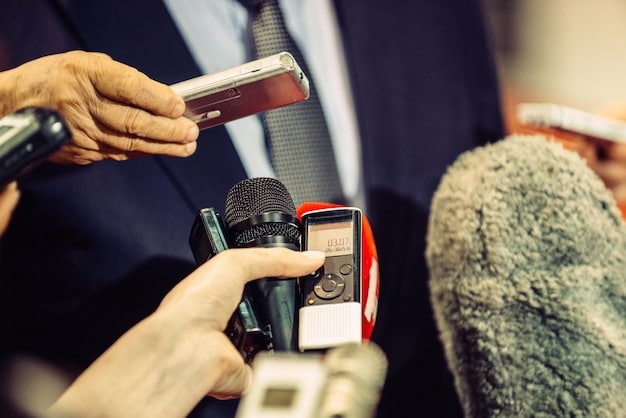Mastering Mobile Journalism: Essential Techniques for 2025

Anúncios
Mastering mobile journalism in 2025 involves leveraging advanced smartphone capabilities, AI-driven editing tools, and enhanced cybersecurity practices for live, impactful field reporting.
Anúncios
The world of news is evolving at an unprecedented pace, and at the forefront of this transformation is mobile journalism (MoJo). As we approach 2025, mastering mobile journalism is no longer just an option but a necessity for reporters aiming to deliver timely and engaging news from the field.
Essential Equipment for Mobile Journalism in 2025
To excel in mobile journalism by 2025, having the right equipment is paramount. Smartphones have become powerhouses of journalistic potential, but selecting the right accessories can significantly enhance the quality and professionalism of your reporting. This section explores the essential gear you’ll need.
Anúncios
Smartphone Selection and Setup
Choosing the right smartphone is the foundation of your MoJo toolkit. Look for devices with high-quality cameras, excellent audio recording capabilities, and sufficient storage. Optimize your phone’s settings to ensure the best possible performance.
Audio Equipment: Microphones and Recorders
Audio quality is crucial for effective storytelling. Invest in external microphones that can connect to your smartphone to capture clear and crisp sound. Portable audio recorders can also serve as a backup or primary recording device.

- Lavalier Microphones: These clip-on mics are great for interviews and on-the-go reporting.
- Shotgun Microphones: Ideal for capturing directional sound and reducing background noise.
- Portable Recorders: Devices like the Zoom H1n offer high-quality audio recording with easy smartphone integration.
Selecting the right equipment is the first step toward professional mobile journalism. By investing in quality smartphones and audio accessories, you can ensure your reports are both visually appealing and audibly clear.
Advanced Filming Techniques for Mobile Journalists
Beyond having the right equipment, mastering advanced filming techniques is crucial for creating compelling mobile journalism content. This section covers essential techniques that will elevate your storytelling, focusing on visual composition, camera movement, and lighting.
Composition and Framing
Understanding composition is key to creating visually appealing shots. Use techniques like the rule of thirds, leading lines, and symmetry to draw the viewer’s eye and create a balanced frame.
Camera Movement: Smooth and Steady
Smooth camera movements are essential for professional-looking videos. Avoid shaky footage by using stabilizers, tripods, or even simple techniques like bracing your elbows. Practice panning, tilting, and zooming smoothly.
- Rule of Thirds: Divide your frame into nine equal parts and place key elements along these lines or intersections.
- Leading Lines: Use natural lines in the environment to guide the viewer’s eye toward the subject.
- Stabilization: Use gimbals or tripods to ensure steady shots.
Advanced filming techniques can significantly enhance the visual quality of your mobile journalism. By mastering composition, camera movement, and lighting, you can create engaging and professional content.
Leveraging AI for Mobile Journalism in 2025
Artificial intelligence (AI) is poised to revolutionize mobile journalism by 2025. AI-powered tools can assist with everything from automated transcription and translation to video editing and content optimization. This section explores how you can leverage AI to enhance your MoJo workflow.
AI-Powered Editing Tools
AI-driven editing tools can automate repetitive tasks, saving time and improving efficiency. Features like automatic scene detection, smart cropping, and AI-assisted color correction can streamline your editing process.
Automated Transcription and Translation
AI-powered transcription and translation services can quickly convert audio and video content into text, making it easier to create subtitles, generate transcripts, and reach a global audience. These tools can also help with content accessibility.

- Descript: An AI-powered audio and video editing tool that automatically transcribes and edits content.
- Otter.ai: A transcription service that provides accurate and fast transcriptions for interviews and voiceovers.
- Lumen5: An AI-driven platform for creating engaging video content from text.
Integrating AI into your mobile journalism workflow can significantly boost productivity and content quality. By leveraging AI-powered editing tools, transcription services, and content optimization platforms, you can create compelling and efficient news reports.
Cybersecurity for Mobile Journalists in the Field
In an increasingly digital world, cybersecurity is a critical concern for mobile journalists. Especially when reporting from the field, protecting your data, sources, and communications is paramount. This section outlines essential cybersecurity practices for MoJo professionals in 2025.
Secure Communication Channels
Use encrypted messaging apps and VPNs to protect your communications from eavesdropping. Signal, WhatsApp (with end-to-end encryption), and ProtonMail are good options. A VPN can mask your IP address and encrypt your internet traffic.
Data Protection and Encryption
Encrypt sensitive data on your smartphone and external storage devices. Use strong passwords and two-factor authentication wherever possible. Regularly back up your data to a secure cloud storage or external hard drive.
Cybersecurity is a non-negotiable aspect of modern mobile journalism. By adopting secure communication channels, protecting your data, and verifying sources, you can safeguard your work and maintain the integrity of your reporting.
Monetizing Mobile Journalism Content
As mobile journalism becomes more prevalent, finding sustainable ways to monetize your content is essential. This section explores various monetization strategies that mobile journalists can leverage in 2025, from platform partnerships to direct audience funding.
Platform Partnerships and Revenue Sharing
Collaborate with established news platforms and media outlets to distribute your content and share revenue. Many platforms offer partnership programs that allow you to monetize your videos and articles through advertising or subscriptions.
Direct Audience Funding and Subscriptions
Build a direct relationship with your audience and offer exclusive content or early access through subscription services like Patreon or Substack. Crowdfunding platforms like GoFundMe can also help fund specific projects or initiatives.
- Patreon: A platform for creators to offer exclusive content to paying subscribers.
- Substack: A platform for journalists and writers to publish newsletters and offer subscriptions.
- YouTube Partner Program: Monetize your YouTube videos through advertising revenue.
Monetizing your mobile journalism content requires a multifaceted approach. By leveraging platform partnerships, direct audience funding, and social media engagement, you can create a sustainable business model that supports your reporting.
Future Trends in Mobile Journalism
Looking ahead to 2025, mobile journalism is set to undergo significant advancements and transformations. Embracing these future trends will be crucial for staying ahead in the industry. This section explores the key trends shaping the future of MoJo, including augmented reality (AR), virtual reality (VR), and 5G technology.
Augmented Reality (AR) and Virtual Reality (VR) Integration
AR and VR technologies offer immersive storytelling opportunities for mobile journalists. AR can overlay digital information onto the real world, while VR can transport viewers to a different environment. These technologies can enhance engagement and provide new perspectives on news stories.
5G Technology and Real-Time Reporting
The rollout of 5G technology will enable faster and more reliable data transfer, facilitating real-time reporting from the field. Mobile journalists will be able to stream high-quality video and audio with minimal latency, enhancing their ability to deliver breaking news.
- AR News Apps: Apps that overlay digital information onto real-world environments for enhanced storytelling.
- VR News Experiences: Immersive VR experiences that transport viewers to different news environments.
- 5G Enabled Live Streams: High-quality live video streams with minimal latency for real-time reporting.
The future of mobile journalism is bright, with emerging technologies like AR, VR, and 5G promising to revolutionize the way news is gathered and consumed. By embracing these trends, mobile journalists can continue to innovate and deliver impactful stories in 2025 and beyond.
| Key Point | Brief Description |
|---|---|
| 📱 Essential Equipment | High-quality smartphones, microphones, and portable recorders for superior reporting. |
| 🎬 Advanced Filming | Techniques including rule of thirds and stable camera movements enhance visual storytelling. |
| 🤖 AI Integration | AI automates tasks like transcription, translation, and video editing, improving efficiency. |
| 🔒 Cybersecurity | Protect data and communications with encryption and secure channels in journalism. |
FAQ
How can mobile journalism benefit from AI in 2025?
AI can automate repetitive tasks like transcription and editing, enhance content personalization, and improve distribution strategies.
What are the best audio recording practices for mobile journalism?
Use external microphones, monitor audio levels, and choose quiet environments to ensure crisp and clear sound quality.
How can mobile journalists protect their sources and data in the field?
Use encrypted messaging apps, secure your devices with strong passwords, and avoid public Wi-Fi networks to mitigate cybersecurity risks.
What role will 5G technology play in the future of mobile journalism?
5G will enable faster and more reliable data transfer, facilitating real-time reporting, high-quality live streams, and immersive storytelling experiences.
What are the key considerations for monetizing mobile journalism content?
Build a strong brand, engage with your audience, diversify revenue streams with ads and subscriptions, and offer exclusive content for paying subscribers.
After mastering the techniques and technologies outlined, future mobile journalists will be fully equipped to thrive in an ever-evolving digital landscape. By remaining current, resourceful, and creative, they will contribute meaningful stories from around the world!





